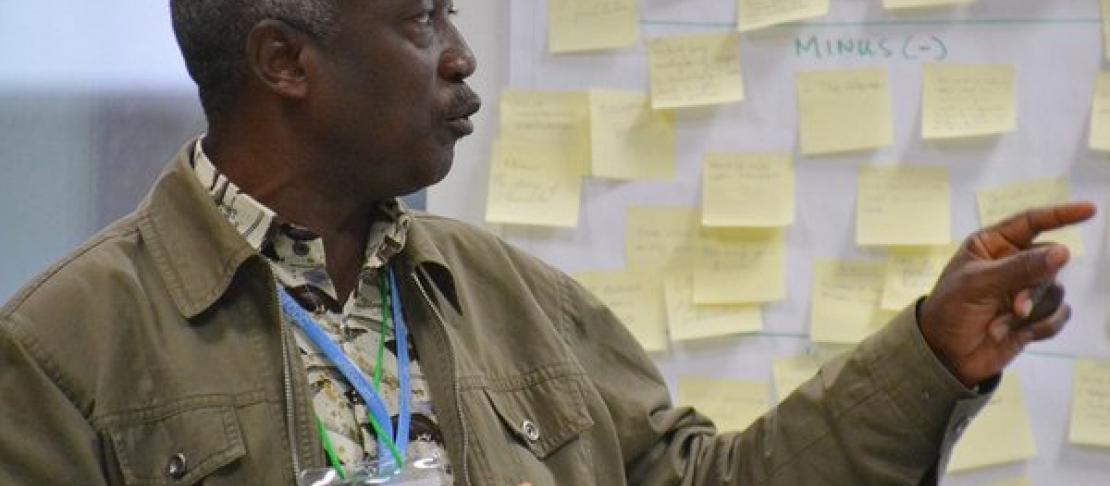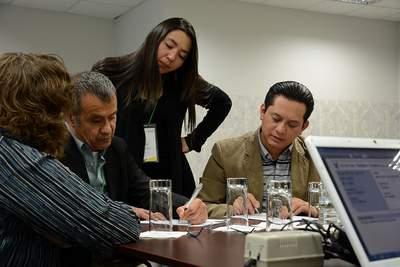The serious business of NAP-ing

A government advisor from India taught members of the Guatemalan Ministry of Agriculture “Namaste.” A delegate from Mali learned how researchers from Kenya say drought (“ukame”) and hunger (“njaa”). And as a program leader from Burkina Faso noted to his gender-specialist-based-in-Colombia companion, “On est ensemble durant deux jours.” We will be together for two days.
And so they were.
As day 2 of the CCAFS learning workshop “Agriculture in National Adaptation Plans” draws to a close, it is evident that countries involved in the National Adaptation Planning (NAP) process share more commonalities than differences. Planning for climate change adaptation in agriculture is not an easy task for any country, so it’s certainly better that they’re all in it together.
What can Kenya learn from Ghana?
Set against the backdrop of the heady negotiations and interminable word-smithing of the 19th session of the UNFCCC Conference of the Parties (COP19) in Warsaw, Poland, the workshop made a point of setting a tone that was distinctly collaborative and familiar. The 37 participants representing 10 different countries were not here to negotiate; they were here to learn.

Workshop participants represented 10 countries including Guatemala, Kenya, Mali, Ghana, Burkina Faso, and India. Photo: J.L. Urrea
Countries that are just in the beginning stages of creating a NAP – Mali and Guatemala, for instance – were able to cultivate south-south exchanges to inform their NAP approach. Countries like Kenya that have already developed their NAP were able to share their experiences and reflect on further needs.
Workshop participant Victor Orindi, representative from Kenya, has no shortage of lessons to bring back to his home country.
“We are learning a lot from countries who have developed NAPAs [(National Adaptation Programmes of Action)], which were the predecessors of NAPs,” he says. These countries have a lot of pointers for Kenya in terms of rolling out plans that are in the final stages of development.
“The issue of finance seems to stick out strongly,” notes Orindi, explaining that while Kenya has already prioritized adaptation options, the resources to implement them remain inadequate. “We need to find an innovative way to liberate those resources wherever they might be available.”
If anything, the variety of experiences that each country brings to the table means that everyone has something to learn – even two countries on opposite sides of the African continent.
Kofi Delali Nutsukpo, charismatic representative from the Ghanaian Ministry of Food and Agriculture, brings with him a wealth of knowledge that could become part of the solution to the financial obstacles experienced by Kenya – and most other countries involved in the NAPs process, for that matter.
“Adaptation planning should not be seen as separate from national development planning,” Nutsukpo asserts. In fact, linking the two is absolutely essential for a sustainable economic development strategy.
According to Nutsukpo, “Getting adaptation plans in line with development plans actually facilitates the availability of funding to implement them, starting from the national level.”
Different approaches, similar goals
In his statement, Nutsukpo highlighted one of the distinctive features of a NAP: the promotion of adaptation mainstreaming into development and sectoral plans. Countries involved in the workshop shared tools and approaches to address this need for multi-stakeholder analysis in cross-sectoral project plans; Ghana’s Strategic Environmental Assessment uses just such an approach, called “Akropong.”
In addition to identifying the need for greater financial mobilization, countries also pointed to capacity building and improved climate data to assess the potential economic impacts of adaptation options. Similar conclusions were drawn in the report recently published by CCAFS, “Planning climate adaptation in agriculture,” also available online on the CCAFS website.
They may have been speaking different languages, but they all had something to share on the subject – and they all came away with new tools in their pockets to support them in the complicated task of NAP-building.
View the presentation given during the workshop by the report’s lead author, Gabrielle Kissinger:
See all presentations from the Agriculture and National Adaptation Plans workshop on the CCAFS slideshare.
View photos from the workshop, 13-14 November 2013 in Warsaw, Poland:
More from this workshop
Learn more aout National Adaptation Plans
Planning climate adaptation in agriculture (CCAFS Report No. 10)
New report highlights lessons from national adaptation planning
Related posts on our blog
Tackling climate change: Kenya holds first national planning meeting for agriculture
Agriculture in focus: Climate change planning in Kenya
With proper planning, farmers can thrive in a world of shifting climates
Caity Peterson is a visiting researcher based at the International Center for Tropical Agriculture (CIAT) in Colombia, working in the CGIAR Research Program on Climate Change, Agriculture and Food Security (CCAFS).
Input provided by Gabrielle Kissinger, Lexeme Consulting.
The CCAFS team is reporting live from the UNFCCC climate talks in Warsaw, 11-22 November 2013. Click to read all of our coverage. For live updates from the Climate talks in Warsaw, follow us on twitter @cgiarclimate and @bcampbell_CGIAR. Join the conversation using #GLFCOP19.



